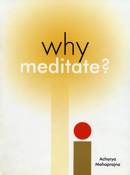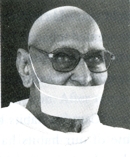
 How are the practices of spirituality and nirjara [shedding of karmas] related to breaking the bondages of our karmas? We need to find out this relationship. A person fasted and did not eat. This is a physical act, but the vibrations that have been set in motion, by his resolution of not eating, affect his karmic body and nirjara takes place. We may also see that one man experiences great difficulty in fasting while another person doesn't even feel any hunger pangs. Now, the question would be, "Who will be experience greater benefit? i.e., Whose bondages will be broken to a greater extent?"
How are the practices of spirituality and nirjara [shedding of karmas] related to breaking the bondages of our karmas? We need to find out this relationship. A person fasted and did not eat. This is a physical act, but the vibrations that have been set in motion, by his resolution of not eating, affect his karmic body and nirjara takes place. We may also see that one man experiences great difficulty in fasting while another person doesn't even feel any hunger pangs. Now, the question would be, "Who will be experience greater benefit? i.e., Whose bondages will be broken to a greater extent?"
If our answer is that benefit is in proportion to the pain experienced, it would actually be a misinterpretation. It would mean the more pain we experience, the more we destroy karmas. Whereas, Jainism does not believe in giving pains to the body at all. If you go on giving pains to your body, then why seek the eternal bliss of Moksha? You are willing to gain happiness by giving pains to your body: isn't this a crazy contradiction? Happiness should be gained only through happiness, not by pain. A person who produces strong and vital vibrations while resolving to fast may not experience any pain, but would have more nirjara, i.e., he would shed more karma. One whose resolve is not strong may not have comparable nirjara, even though he may experience pain all through the day. Which person produced stronger vibrations, and at which instant? It all depends upon the exertion that spurs vital vibrations. The vibrations produced would reach within and vibrate our karmic body and thereby throw away foreign karmic particles residing there. This is how the process of shedding of karmas takes place in the subtlest body.
The complete technique of Preksha Meditation is a method based on the principle of nirjard. How can we purify our soul? The act of control also accompanies this. When can we control the influx of karmic particles? If the process of purification of karmas has been done properly, the process of stopping the entry of new karmic particles will also be effective. If the process of shedding is not correct, stopping new karmas from bonding will also be difficult. Mere vocal promises cannot stop the bonding of new karmas.
We must take the support of these practices for changing our nature. When does purification take place effectively? We should think about this. The autosuggestions given to our body while practicing Kayotsarg are an infallible way to change our nature. What would happen if you autosuggest while in an unstable state? Your body and mind are unstable, your nervous system is very active, and your brain is also over-active. In such a situation, your autosuggestions may not be fruitful. Suggestion is a very important technique to change our nature, be they autosuggestions or suggestions from another person. Suggestions play a very important role in our transformation. We can transform ourselves by means of suggestions. Suggestions are grasped even by our subconscious mind. Even the nerves of our brain start to transform. Also, the vibrations start coming from within the karmic body and together accomplish the procedure of transformation. That is why we practice special techniques of suggestions in Anupreksha (contemplation or autosuggestion). I have experienced that the techniques of Anupreksha are very powerful in producing transformations. This practice is not commonly found in other mediation techniques.
One of the techniques of Anupreksha is contemplation of forbearance. Intolerance has almost become a part of human nature today. A person, who is lacking forbearance, can increase his tolerance power by the practice of Anupreksha of tolerance. A person who lacks softness and is rude, can be made courteous by the practice of Anupreksha of courtesy. A person who could not harmonise his personal and official life came to me. He practiced the Anupreksha of harmony, after which there was a change in his temperament, and he was able to adjust to all kinds of people. If a student is given good suggestions, he will score well in his examinations, be competent in his studies, develop a sharp memory and his nature would also change. The suggestions given in Kayotsarg are very effective.
Some people complain that they keep on thinking, even resolving not to do certain activities, but are never successful. The question is: when should we take a resolve? There are three states favorable for taking a resolve - Kayotsarg (relaxation), Sammohan (hypnosis) and sleep. You must practice relaxation, not mere loosening of muscles. When your Kayotsarg' is firmly established you should practice the technique of autosuggestion. In twenty minutes of Kayotsarg, keep ten minutes completely for relaxation. After that, spend the remaining ten minutes auto-suggesting that 'I want to do this, I want to quit this and I want to accept this.' The language of your suggestions will be accepted well by your brain in Kayotsarg and these will then be taken to the karmic body. The consequent vibrations of your karmic body will reach your brain and initiate the process of transformation.
The second state is Sammohan i.e. the state of hypnosis. It is a technique of emotions and feelings. Today, people have started considering hypnosis to be a malpractice. Actually, hypnosis is not bad, indeed, it is a good practice but many people misuse it. In hypnosis, our consciousness is more easily tamed. Hypnotize a person through suggestions. In this state, his conscious mind will be rendered inactive. At that time, if you give him suggestions, those suggestions will be well received by the subconscious mind. Unless and until suggestions reach the subconscious mind, no transformation can occur. There are many who go on pilgrimages to various religious places like temples, mosques, and churches and make good resolutions at those sacred spots. But as soon as they return to the kitchen or the market, they forget all their resolutions. Why does this happen? The answer is that the resolution reached only the level of gross consciousness. The impression of that resolution was hence formed temporarily, on the conscious mind, and then was washed off. So how would the resolution stand? Transformations are not possible until our resolutions reach the subtler consciousness. I would like to relate a story in this context.
Once a Thakur decided to go on a pilgrimage, and upon reaching that place he resolved to give up something. He came back home. However, his resolution broke due to some reasons. Seeing this, some one said to him, "You were already burdened, now you carried home a hundred more." Why does it happen that we are determined to do something but cannot carry it out? This is because we do not know the correct procedure of transformation as to where and when changes should be made.
Many people come and present me with a long list of different kinds of resolutions and ask me to get help them resolve these. I don't believe in such things. I believe that you must first practice to strengthen your power of resolution. Many a time, people resolve never to perform such-and-such act throughout their lives. It is very difficult to say how long this verbal determination will last, and to which level it will reach. If I'm asked about this, my undoubted answer would be - this is not the correct procedure of transformation. It is necessary to understand and follow the proper methodology of transformation. Otherwise, our resolution remains limited to just an external show.
 Acharya Mahaprajna
Acharya Mahaprajna
 Copyright by Acharya Mahaprajna ©2005
Copyright by Acharya Mahaprajna ©2005